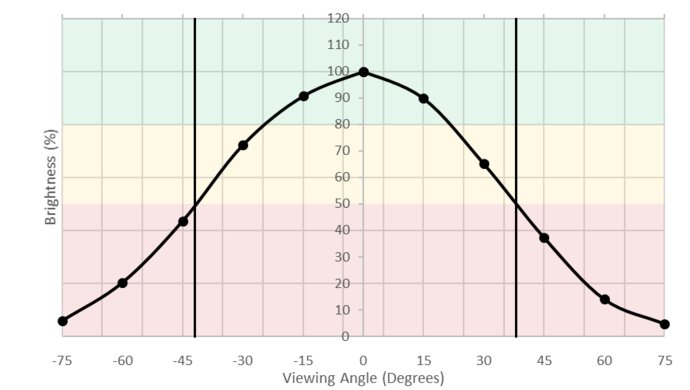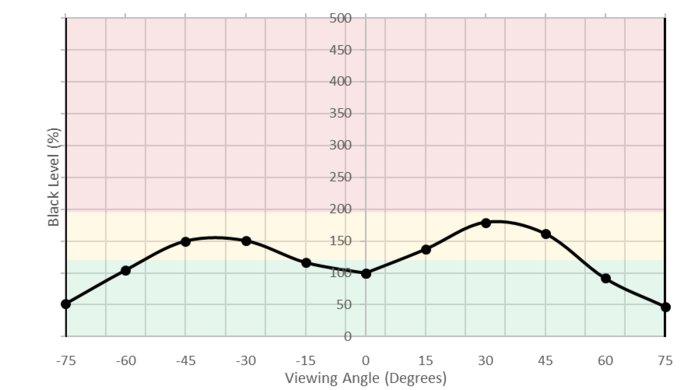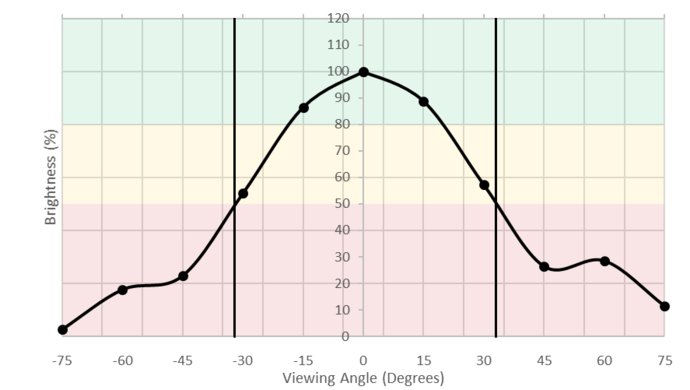The LG 27UD58-B is a good 4k IPS gaming monitor with passable picture quality. It has a few gaming-oriented features such as FreeSync and very low input lag for a 60Hz monitor. Motion handling is also good but limited by the relatively low refresh rate. Unfortunately, backlight bleed is bad when viewed in a dark room and the reflection handling isn't as good as some other monitors when viewed in a bright room.
Our Verdict
The LG 27UD58 is a decent monitor for mixed usage. Gaming-oriented features such as FreeSync and the low input lag result in good gaming performance, but the picture quality is only passable. The sides of the image do remain accurate when viewed from up-close due to the wide viewing angles, which is good.
-
Input lag is very low.
-
Solid colors and backgrounds are uniform.
-
High resolution is great for multitasking.
-
Blacks appear gray and blotchy.
-
Prominent backlight bleed.
The LG 27UD58 is decent for office use. The limited ergonomic adjustments make it less convenient to show images to coworkers or to find a comfortable viewing position for long periods of time. The high resolution is a bonus for productivity and multitasking, which is good. The picture quality of the LG 27UD58-B is only passable, but the image remains accurate when viewed at an angle, which is good.
The LG 27UD58 is a good monitor for gaming. The combination of FreeSync, low input lag, and good motion handling results in a responsive and tear-free experience, which is good. Unfortunately, the 60Hz refresh rate limits the performance for fast-paced games and the picture quality is only decent.
The LG 27UD58 is a decent monitor for media consumption. Coverage of the most used sRGB color space is great, and the gray uniformity is good. The image also remains accurate when viewed at an angle, which is great. Unfortunately, the picture quality is only passable and is limited by the low native contrast ratio and poor black uniformity of the IPS panel.
The LG 27UD58 is decent for editing photos or videos. The out of the box image accuracy is great, and the image also remains accurate when viewed at an angle. Unfortunately, the low native contrast ratio and poor black uniformity reduce the picture quality.
The LG 27UD58 doesn't support HDR.
- 7.2 Mixed Usage
- 7.4 Office
- 7.5 Gaming
- 7.1 Multimedia
- 7.1 Media Creation
- 5.3 HDR Gaming
Changelog
- Updated Jul 02, 2021: Changed height adjustment result from 'N/A' to '0' to match our methodology.
- Updated Jan 17, 2019: We tested the monitor's compatibility with NVIDIA's new FreeSync driver. See our full investigation into NVIDIA's FreeSync Drivers here.
- Updated Jan 22, 2018: Review published.
- Updated Jan 20, 2018: Our testers have started testing this product.
- Updated Jan 20, 2018: Early access published.
Check Price
Differences Between Sizes And Variants
We tested the 27" model (27UD58B-P). However, the monitor is also available in 24" (24UD58B-P). It is also closely related to the higher end 27UD68, which is available in white (27UD68P-W) and black (27UD68P-B) variants.
If someone comes across a different type of panel or if their 27UD58B-P doesn't correspond to our review, let us know and we will update the review. Note that some tests such as the gray uniformity may vary between individual units.
| Model | Size | Refresh rate | Notes |
|---|---|---|---|
| 24UD58-B | 24" | 60Hz | |
| 27UD58-B | 27" | 60Hz | |
| 27UD68P-B | 27" | 60Hz | Black variant |
| 27UD68P-W | 27" | 60Hz | White variant |
| 27UK650-W | 27" | 60Hz | White variant |
Compared To Other Monitors

The LG 27UD58B-P is a decent 4k monitor with an IPS screen and FreeSync support. It is one of the best gaming monitors under $300 we have tested. See our recommendations for the best monitors for Xbox One X and the best PC gaming monitors.
The LG 27UD68P-B is better than the LG 27UD58-B, but overall, performance is very similar between the two. The 27UD58-B has a fixed stand that has extremely limited flexibility, whereas the 27UD68P-B has a telescoping stand and can rotate between a portrait and landscape orientation. The 27UD58-B is brighter as well.
The LG 27UD58-B is better than the LG 29UM69G-B. The LG 27UD58-B has a 4K UHD resolution with more detail that makes it easier to multitask, like when you're creating media or watching multimedia while browsing the net. On the other hand, the LG 29UM69G-B has a slightly better refresh rate, a faster pixel response time, and supports black frame insertion (BFI) to clear up blur. All these features are good news for those who plan to use it for video gaming.
The LG 27UD58-B is much better than the Samsung UE590. The LG 27UD58-B has much wider viewing angles, and there are no duplications in moving objects as the backlight is flicker-free. The 27UD58 has better gray uniformity, which is great for watching streaming sports.
The LG 27UD58-B is slightly better than the Dell U2717D. The 27UD58-B has wider viewing angles and is better suited for gaming with much lower input lag and support for AMD's FreeSync technology. The higher resolution of the 27UD58-B makes it easier to multitask, but can be a bit more demanding on a PC. The Dell U2717D has far more ergonomic options, so it is easier to place it in a comfortable position.
The LG 27UD58-B is significantly better than the Sceptre C325W. The LG 27UD58-B has better viewing angles due to its IPS panel. It also has a much lower input lag and a faster pixel response time and supports the FreeSync VRR implementation which is excellent if you play games. The LG 27UD58-B has a much better resolution that allows it to display more detail on the screen. The Sceptre C325W, on the other hand, has a higher native contrast ratio that delivers deep blacks, and a better reflection handling so it can be placed in a room with many small light sources.
The LG 27UK650-W is much better than the LG 27UD58-B. The LG 27UK650 has better ergonomics, making it easier to place it comfortably. The LG 27UK650 has marginally better vertical viewing angles and marginally better SDR peak brightness, which are important for office use. Finally, the LG 27UK650 supports HDR content and has better black uniformity, which make it a better choice for multimedia watching.
The Dell U2518D is much better than the LG 27UD58-B. The Dell U2518D supports HDR whereas the LG 27UD58-B doesn't. The Dell U2518D has better motion blur for slightly better gaming and significantly better ergonomics that allow you to place it more comfortably. The Dell U2518D can get brighter, and this is great for office use. On the other hand, the LG 27UD58-B has a better resolution which makes it slightly better for those who seek the extra detail. Also, the LG 27UD58-B has better input lag and better refresh rate.
The LG 27UD58-B is somewhat better than the HP 27Q. The LG 27UD58-B has a better input lag and is more responsive to your actions. It also has better resolution allowing you to display more in the same screen size. On the other hand, the HP 27Q is brighter and can handle reflections better, so it's more suitable for a slightly brighter room with many light sources.
Test Results
The design of the LG 27UD58-B monitor is good. The monitor looks good from the front, due to the fairly unique crescent stand. The black borders also look good, even if they are a bit thicker than most other monitors. Unfortunately, the ergonomic adjustment options are limited with only the ability to tilt the monitor which can make it difficult to find a comfortable viewing position. The build quality is decent, and the stand feels stable.
Update 07/02/2021: We previously had incorrectly listed the Height Adjustment as 'N/A' as opposed to '0'. The review has been updated to reflect this change, as the Ergonomics score has dropped slightly.
The ergonomic adjustments of the LG 27UD58-B are very limited, which can make it difficult to find a comfortable viewing position or to share images with coworkers.
The rear of the monitor is basic but looks good. All of the inputs are located on the same panel and do stick directly out the back, which may make them more difficult to connect in some setups. It looks quite similar to the 27UD68P-B, but with a matte plastic finish instead of glossy.
The LG 27UD58-B monitor appears quite thin when viewed from the side. It has two tiers of thickness, but even the thicker part where the VESA mount attaches is quite thin, and the monitor sits close to a wall with the stand attached.
The monitor has a passable contrast ratio. With a contrast ratio just shy of 1000:1, the monitor won't be the best monitor to use in a dark room since it can't really reproduce deep blacks which is important for dark video content. When set in a bright room though, the LG 27UD58-B does a much better job and is on par with other IPS monitors.
This monitor does not feature a local dimming option. The video is for reference only.
The SDR peak brightness is decent. It can't get as bright as the LG 27UD68P-B, but doesn't dim at all when showing static images which is good.
HDR is not supported.
The horizontal viewing angle is decent. When viewed at an angle, the colors do shift, but much less so than monitors with TN or VA panels such as the Samsung CHG70 and Dell S2716DG. The brightness also drops off as seen in the video.
Great gray uniformity for the LG 27UD58-B. Looking at the 50% gray test picture, we can see that the regions near the top and bottom of the screen are a bit darker than the center regions, but besides that nothing really striking can be noticed.
When it comes to the 5% gray uniformity, this LG monitor does a good job, as nothing really bad can be noticed. Overall, this is a good result for this monitor.
The black uniformity of this LG 27UD58-B monitor is poor. Backlight bleed is prominent near each corner of the screen, with the lower right one being the better of them. This poor black uniformity means that dark video content, like dark video cut-scene from video games or any other dark multimedia content, will suffer from this uniformity issues, especially when the monitor is used in a dark room. This is less of an issue if the monitor is used to do office work, as the dark content is more rare.
Out of the box, this monitor has great accuracy. The best measurement was done under the 'Custom' picture mode, but all the other picture modes gave reasonably good readings, except the 'Reader' picture mode, which had a white balance and color dE around 10.
The low white balance dE and color dE (both under 3.0), paired with good color temperature, means this monitor really gives good accuracy, which should be plenty good for most people. The gamma is a bit below our 2.2 target, and the curve does not track that closely our target curve, but for out of the box settings this is still pretty good.
Overall, the LG 27UD58-B could be used by most people, except maybe professionals, without any calibration.
Update: The luminance value has been updated, as there was an error when the data was entered into our system. The good luminance data is 253.9 cd/m² instead of 523.9 cd/m².
After calibration, the accuracy of the LG 27UD58-B is excellent. The change in accuracy from the 'Out of the box' settings is not enormous since the monitor had already a good accuracy, but there was still some place for improvement. Now, both white balance dE and color dE are under 1.0, at which point, almost nobody can discern inaccuracies. Looking at the CIE color space image, we can see that the colors that were a bit oversaturated (mostly in the reds and greens) are now tracking much more closely to their targets. As for the gamma, that was a bit low and not tracking the target curve very closely, is now almost spot on on both aspects.
Overall, this monitor is very accurate and should give anyone who uses it a very good experience.
You can download our ICC profile calibration here.
HDR is not supported.
The LG 27UD58-B does an amazing job at displaying our gradient test image, as we can see in our test picture. Almost no banding is visible at all, besides some very minimal banding in the dark part of the colors. As this monitor support 10-bit input, no banding generally seen on an 8-bit monitor is visible, overall, this is an excellent result.
Response Time Off
Response Time Low
Response Time Middle
Response Time High
Good pixel response time, good enough for fast motion in video games and TV shows. This results in a clear image with only a short trail visible as shown by the photo above. The 'Response Time Middle' setting was the most balanced and the 'High' setting produced a slightly faster rise time. Unfortunately, it also added a distracting amount of overshoot and therefore, is not recommended.
Overall, the response time is slightly worse than the 27UD58-B's sibling, the 27UD68P-B, but this could just be variance from unit to unit. The competing Samsung UE590 4K monitor has a more significant response time advantage though.
Like most monitors, the LG 27UD58 has a flicker-free backlight, which is great as this results in smoother motion. Unfortunately, the monitor lacks a black frame insertion feature to intentionally add flicker to clear up motion when playing fast-paced video games. However, it's common for a 60Hz monitor to lack BFI because many people find 60Hz flicker distracting.
The monitor has a fairly ordinary 60Hz maximum refresh rate; this is good enough for most usages but everyone would benefit from a higher refresh rate, especially gamers. Fortunately for gamers, the monitor supports FreeSync variable refresh rate technology, although only within a fairly narrow range of 40-60Hz.
The monitor has two different FreeSync modes: 'Basic' (range 48-60Hz) and 'Extended' (range 40-60Hz). We recommend using the 'Extended' range, and only using the 'Basic' range as a fallback for games that have problems with the 'Extended' range. Also, it was discovered that FreeSync only works properly when the monitor's 'Ratio' setting is set to 'Wide' and has problems when 'Ratio' is set to 'Original'.
Update 01/15/2019: We have tested the 27UD58 with NVIDIA's new FreeSync drivers. The 'Extended' mode does not work properly and caused worse tearing. The 'Basic' FreeSync mode on the monitor works without any serious issues, across the 48-60Hz range.
Great low input lag, good enough for all but the most competitive gamers. The input lag stays fairly consistent in all situations, even when using FreeSync, which is good.
The monitor's defining feature is its very sharp 4K UHD resolution, which can show every pixel in 4K movies and TV shows in all their glory. All these pixels are shown on a panel with a modest 27" size, giving the monitor a very high pixel density; this is great for most applications, but it can make text too small to read comfortably when DPI scaling isn't used. This size and resolution are the same as the LG 27UD58-B's sibling, the 27UD68P-B; the competing Samsung UE590 4K monitor is slightly larger at 28", but has worse picture quality in general.
The LG 27UD58-B monitor has a few extra features that are useful in certain situations. The 'Super Resolution+' feature uses better upscaling image processing than the default, which can be useful when the monitor is being used at a lower resolution like 1080p. The 'Black Stabilizer' feature warps the monitor's gamma curve to brighten or darken dark details like shadows, which can be useful when playing some competitive games. The monitor also has an 'Automatic Standby' timer to put the monitor on standby after 4, 6 or 8 hours.
The LG 27UD58-B monitor's on-screen display is controlled by a small joystick nub on the screen's bottom edge, which also doubles as the power button. This joystick turns out to be a really intuitive way to navigate the OSD, better than the four button scheme used by most monitors. Many other LG monitors use this joystick, like the 29UM69G-B, as well as many Samsung monitors like the CHG70.
Comments
LG 27UD58-B: Main Discussion
Let us know why you want us to review the product here, or encourage others to vote for this product.

































































































